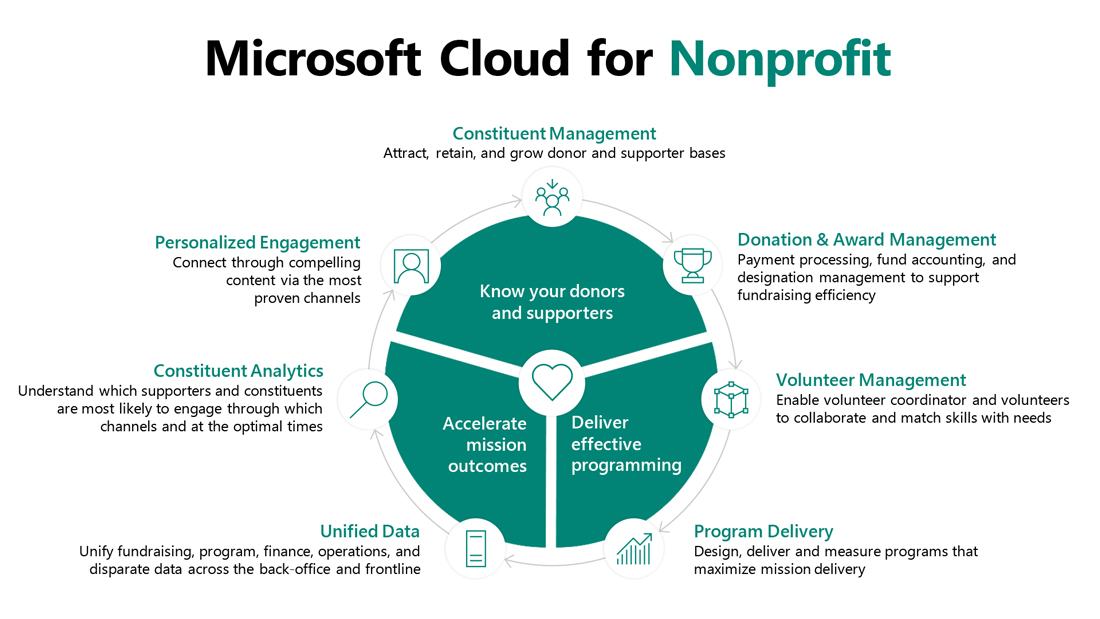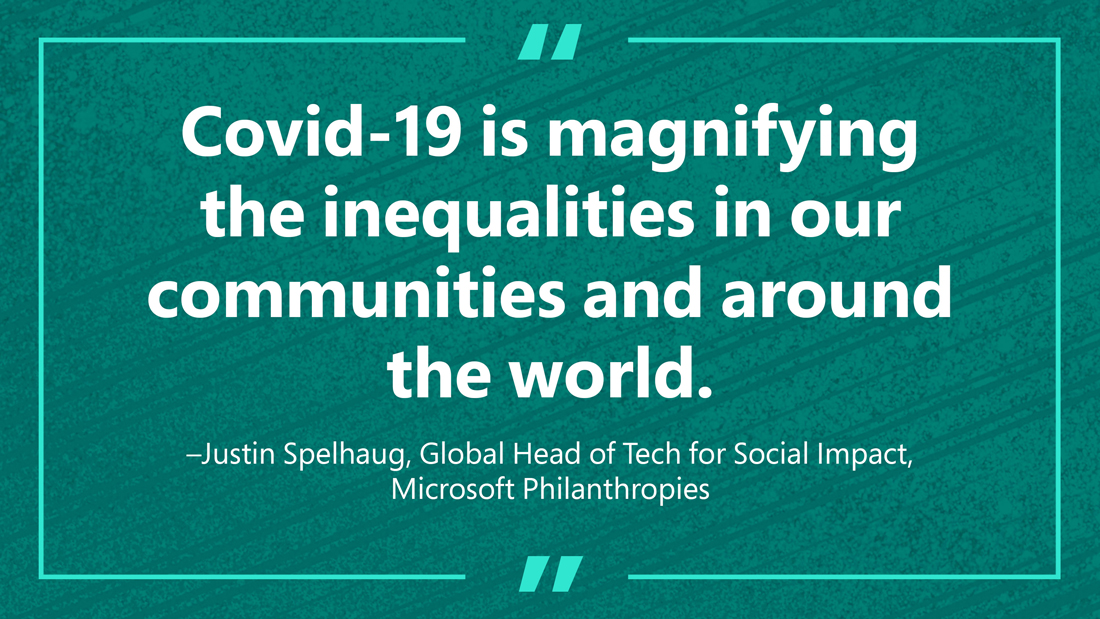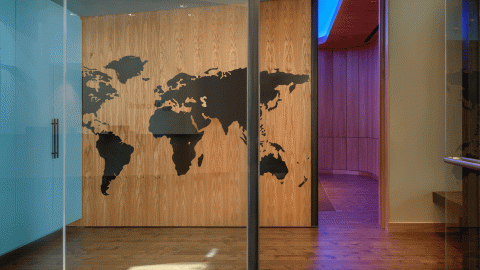What does the cloud have to do with philanthropy? A Q&A with Justin Spelhaug on helping nonprofits with digital transformation
Before the pandemic, the thousands of U.S. military veteran volunteers who make up the nonprofit organization Team Rubicon would be called on to help after hurricanes, earthquakes and other natural disasters. Now, they are involved with one of the most logistically challenging peacetime ventures the U.S. has ever contended with: the coronavirus vaccination program.
Administering vaccines to millions of people around the country is a huge task. Team Rubicon has been using Microsoft technology to bring together volunteers in a way that was previously not possible to ensure that people in the U.S. have better access to the Covid-19 vaccine.
Microsoft today announced its Microsoft Cloud for Nonprofit and its plans to develop solutions for common scenarios nonprofits like Team Rubicon face that can be improved through technology. With fewer resources and less funding because of the pandemic, greater efficiency is essential. Microsoft Cloud for Nonprofit is designed to meet the needs of nonprofits and to further expedite the reach and scale of their work. It is part of the company’s broader industry cloud announcement.
We caught up with Justin Spelhaug, who leads Tech for Social Impact at Microsoft, to learn more. His team, within Microsoft Philanthropies, provides nonprofits with affordable technology, services and training to help them advance their missions. It is this team, along with Microsoft partners, that will help deploy Microsoft Cloud for Nonprofit around the world.
Justin, will you walk us through the technology of Microsoft Cloud for Nonprofit
Over the last several years, we’ve been working side-by-side with the nonprofit sector, including organizations like Team Rubicon, to identify the most common scenarios nonprofits face. Every time nonprofits took on a technology project, they were having to reinvent the wheel because of the lack of solutions built for their challenges. So, by building sector-specific solutions and investing in a common data model, we can help take friction out of the equation for nonprofits. It becomes easier, faster and less expensive for nonprofits to adopt modern digital technology and allows them to focus more on their missions.
Specifically, we are bringing together the power of Microsoft 365, Power Platform, Dynamics 365, Azure and LinkedIn. This will make engagement and fundraising, staff collaboration, volunteer engagement and management, and program design and delivery more efficient. In addition, Microsoft Cloud for Nonprofit is underpinned by a Common Data Model for Nonprofits, making it easier and less expensive for nonprofits to integrate with existing solutions and share data across the organization.
In late 2020, we launched our first solution, which now sits within Microsoft Cloud for Nonprofit, called Fundraising and Engagement. It supports common fundraising needs across donation types and channels, including: major and annual giving; recurring gift and membership programs; opportunity and designation management; and household and life event management. Fundraising and Engagement is built on Microsoft Dynamics 365 Sales Enterprise.

There is more innovation to come, including new solutions to power volunteer engagement and management. Volunteers are at the heart of many nonprofits and it’s essential that they are deployed and supported as effectively as possible.
Microsoft Cloud for Nonprofit represents a long-term commitment to innovate for the nonprofit sector, providing the technology nonprofits need to meet the sector’s most urgent challenges so they can achieve more.
[READ MORE: How technology is propelling nonprofits through a crisis to help even more people in need]
Why is technology so important to the delivery of critical services during the pandemic?
Covid-19 is magnifying the inequalities in our communities and around the world. As the demand for nonprofit services significantly grows, resources and funding are tightening up. For many nonprofits, there has never been more pressure to find ways to do more with less – increase the scale of their operations, improve efficiency and protect their beneficiaries’ and donors’ data. Microsoft Cloud for Nonprofit is positioned to play an important role in addressing this pressure and unlocking new opportunities for nonprofits by addressing the most pressing scenarios within a highly secure and unified platform backed by a global ecosystem of partners.

What can Cloud for Nonprofit do for groups like Team Rubicon?
I volunteered with Team Rubicon in Iowa in 2019, helping support the communities that were flooded during the great Midwestern flood in the U.S. We spent days clearing houses of water, mud and debris so that homeowners could start the process of rebuilding their lives. I experienced the very real human impact that the Team Rubicon volunteers make every day.
While support for the Midwestern flood was a large operation, Team Rubicon’s effort to mobilize more than one million volunteers to provide support for Covid-19 vaccinations is orders of magnitude larger and more complex. Vaccine deployment is a complicated operation involving logistics, matching skills to tasks, and running the vaccination sites. That is a lot of moving parts and at massive scale, and it’s simply not something you can just do with a piece of paper and a spreadsheet. Bringing order and structure to this complexity is where technology comes in. Microsoft Cloud for Nonprofit will help Team Rubicon engage, plan and manage the volunteer operations supporting this vaccination effort.
What is the role of partners in Microsoft Cloud for Nonprofit?
The Microsoft partner ecosystem has been with us every step of the way to leverage this foundation and to develop even more solutions for nonprofits. We have partners like Avanade, Wipfli, threshold.world and Soapbox Engage who are already building solutions around Microsoft Cloud for Nonprofit. These solutions are aligned to the Common Data Model for Nonprofits. In addition, we have partners that have been serving the sector for decades. Our strategic partnership with Blackbaud has enabled continued innovation in connecting our platforms and brings their industry-leading fundraising and analytics solutions to the sector, leveraging the Microsoft Cloud – from Azure to integration with Power Apps and the Microsoft 365 productivity suite. These partners provide nonprofits with a broad portfolio of solutions and capabilities that can meet the needs of the sector and can be adopted over time.
Is Microsoft Cloud for Nonprofit available to organizations around the world?
Components of Microsoft Cloud for Nonprofit like the Fundraising and Engagement solution are available now. New capabilities for Fundraising and Engagement will be released in April 2021, including rapid donation management and payment processing capabilities, constituent research powered by LinkedIn Sales Navigator, and proactive insights to improve constituent engagement. Additional tools, Volunteer Engagement and Volunteer Management, will be in public preview by the end of June and generally available in the second half of 2021. All these solutions will be supported globally and will be localized in the near future.
We are already seeing its value globally. Right to Play, an organization with projects across the world that use games and sports to empower children, was an early adopter of the Fundraising and Engagement solution. This empowers the organization to use analytics to attract and retain donors with more targeted campaigns. This is a crucial tool for nonprofits grappling with funding challenges during the pandemic.
Since implementing the platform two years ago, Right to Play has grown its monthly donor numbers 3,000% in their Canadian market alone. They have also collapsed the time to produce fundraising reporting from one day to one minute by using the solution’s automation. For Right to Play, this has been a crucial building block to help them scale to support millions of the world’s most vulnerable children who now need more support than ever.
[READ MORE: More tech and cloud support for nonprofits on the frontline of Covid-19]
What’s next?
In the near term, we are really focused on delivering against this. But technology is just part of the solution. We are working to ensure that nonprofits have the services and training they need to democratize data, drive use of the platform and advance their mission during this incredibly challenging time. That said, we are just scratching the surface of the power of technology in this sector. There is just so much potential to make a positive impact through technology, and we’re just getting started.
Sign up to stay updated on Microsoft Cloud for Nonprofit. And join us March 30 for Introducing Microsoft Cloud for Nonprofit, a digital event where you’ll learn about this industry-specific solution, see a demo of the new capabilities in Fundraising and Engagement, hear from nonprofits and have the opportunity to ask questions of Microsoft experts.








